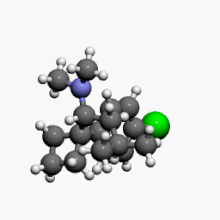Sibutramin
Изглед
 | |
 | |
| Klinički podaci | |
|---|---|
| Prodajno ime | Butramin, Medaria, Meridia, Reductil |
| Drugs.com | Monografija |
| Način primene | Oralno |
| Farmakokinetičkipodaci | |
| Poluvreme eliminacije | 1,1 h |
| Identifikatori | |
| CAS broj | 106650-56-0 |
| ATC kod | A08AA10(WHO) |
| PubChem | CID5210 |
| IUPHAR/BPS | 2586 |
| DrugBank | DB01105 |
| ChemSpider | 5021 |
| KEGG | C07247 |
| ChEMBL | CHEMBL1419 |
| Hemijski podaci | |
| Formula | C17H26ClN |
| Molarna masa | 279,848 |
| |
| |
| Fizički podaci | |
| Tačka topljenja | 191—192 °C (376—378 °F) |
Sibutraminjeorgansko jedinjenje,koje sadrži 17atomaugljenikai imamolekulsku masuod 279,848Da.[1][2][3][4][5][6]
Osobine
[уреди|уреди извор]| Osobina | Vrednost |
|---|---|
| Broj akceptora vodonika | 1 |
| Broj donora vodonika | 0 |
| Broj rotacionih veza | 5 |
| Particioni koeficijent[7](ALogP) | 5,2 |
| Rastvorljivost[8](logS,log(mol/L)) | -5,6 |
| Polarna površina[9](PSA,Å2) | 3,2 |
Reference
[уреди|уреди извор]- ^Sharma, B.; Henderson, D. C. (август 2008). „Sibutramine: Current status as an anti-obesity drug and its future perspectives”.Expert Opinion on Pharmacotherapy.9(12): 2161—73.PMID18671470.S2CID71049588.doi:10.1517/14656566.9.12.2161.
- ^Tziomalos, K.; Krassas, G. E.; Tzotzas, T. (2009).„The use of sibutramine in the management of obesity and related disorders: An update”.Vascular Health and Risk Management.5(1): 441—52.PMC2686261
 .PMID19475780.doi:10.2147/vhrm.s4027.
.PMID19475780.doi:10.2147/vhrm.s4027.
- ^Heal, D. J.; Aspley, S.; Prow, M. R.; Jackson, H. C.; Martin, K. F.; Cheetham, S. C. (1998). „Sibutramine: A novel anti-obesity drug. A review of the pharmacological evidence to differentiate it from d-amphetamine and d-fenfluramine”.International Journal of Obesity and Related Metabolic Disorders: Journal of the International Association for the Study of Obesity.22 Suppl 1: S18—28; discussion S29.PMID9758240.
- ^Stock, M. J. (1997). „Sibutramine: A review of the pharmacology of a novel anti-obesity agent”.International Journal of Obesity and Related Metabolic Disorders: Journal of the International Association for the Study of Obesity.21 Suppl 1: S25—9.PMID9130038.
- ^Knox C, Law V, Jewison T, Liu P, Ly S, Frolkis A, Pon A, Banco K, Mak C, Neveu V, Djoumbou Y, Eisner R, Guo AC, Wishart DS (2011).„DrugBank 3.0: a comprehensive resource for omics research on drugs”.Nucleic Acids Res.39(Database issue): D1035—41.PMC3013709
 .PMID21059682.doi:10.1093/nar/gkq1126.
.PMID21059682.doi:10.1093/nar/gkq1126.
- ^David S. Wishart; Craig Knox; An Chi Guo; Dean Cheng; Savita Shrivastava; Dan Tzur; Bijaya Gautam; Murtaza Hassanali (2008).„DrugBank: a knowledgebase for drugs, drug actions and drug targets”.Nucleic acids research.36(Database issue): D901—6.PMC2238889
 .PMID18048412.doi:10.1093/nar/gkm958.
.PMID18048412.doi:10.1093/nar/gkm958.
- ^Ghose, A.K.; Viswanadhan V.N. & Wendoloski, J.J. (1998).„Prediction of Hydrophobic (Lipophilic) Properties of Small Organic Molecules Using Fragment Methods: An Analysis of AlogP and CLogP Methods”.J. Phys. Chem. A.102:3762—3772.doi:10.1021/jp980230o.
- ^Tetko IV, Tanchuk VY, Kasheva TN, Villa AE (2001).„Estimation of Aqueous Solubility of Chemical Compounds Using E-State Indices”.Chem Inf. Comput. Sci.41:1488—1493.PMID11749573.doi:10.1021/ci000392t.
- ^Ertl P.; Rohde B.; Selzer P. (2000).„Fast calculation of molecular polar surface area as a sum of fragment based contributions and its application to the prediction of drug transport properties”.J. Med. Chem.43:3714—3717.PMID11020286.doi:10.1021/jm000942e.
Literatura
[уреди|уреди извор]- Hardman JG, Limbird LE, Gilman AG (2001).Goodman & Gilman's The Pharmacological Basis of Therapeutics(10. изд.). New York: McGraw-Hill.ISBN0071354697.doi:10.1036/0071422803.
- Thomas L. Lemke; David A. Williams, ур. (2007).Foye's Principles of Medicinal Chemistry(6. изд.). Baltimore: Lippincott Willams & Wilkins.ISBN0781768799.
Spoljašnje veze
[уреди|уреди извор]
 | Molimo Vas, obratite pažnju navažno upozorenje u vezi sa temama izoblasti medicine (zdravlja). |
